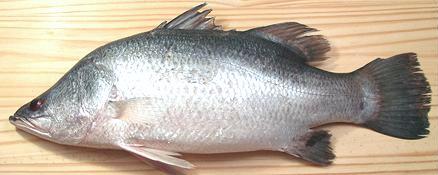 [Giant Perch, Asian seabass, White seabass; Bekti (India); Bhetki
(Bengali); Pla kapong (Thai); Siakap (Malay); Lates calcarifer]
[Giant Perch, Asian seabass, White seabass; Bekti (India); Bhetki
(Bengali); Pla kapong (Thai); Siakap (Malay); Lates calcarifer]
This Indo-Pacific fish is very important in Southeast Asia and northern Australia, and also much appreciated in West Bengal and Bangladesh. Both wild and farmed, it is a sought after fish that fetches a premium price. It can grow to 78 inches and 132 pounds, but the photo specimen was 17 inches long, weighed 2 pounds 14 ounces. It probably came from a fish farm in Thailand, but a growing number are farmed in North America. They are also farmed in Indonesia, Malaysia and Australia, with smaller operations in the UK and Holland.
More on the Perch Families.
Barramundi is a very fine eating fish, with delicate flesh and delicate flavor. Saltwater caught or farmed is considered best because river caught may have a lot of fat. You should not use strongly flavored sauces with this fish as they would swamp its delicate flavor - enjoy it as natural as possible and cooked a very short time.
Buying: At the time of writing (early 2010) this fish has become fairly common in the Asian markets here in Los Angeles, often labeled "Giant Perch" - and surprise! It actually is a perch. While the fish in the photo was purchased in 2010, a smaller one (2 pounds) I purchased from a Philippine market in Los Angeles (Eagle Rock, actually) was 2015 US $3.99 / pound.
Scales: Barramundi is completely covered with large strong scales with good adhesion so it takes a bit of energy to scrape them off and they will fly about everywhere. By time I've scaled a couple of big ones I'm so covered with scales I look like a fish. Some clumps of scales, particularly just behind the head, will be stubborn, but you can pull the clumps off with your long nose pliers.
Cleaning: Barramundi is more difficult than some fish because there's a lot of stuff in there and some of it adheres tightly to the bone structure. Use long nose pliers for what you can't pull easily by hand, and you'll want to cut the gills out with kitchen shears.
Fillet: Barramundi is pretty easy to fillet, but there is a large gap between the fin rays and the short ribs coming up from the backbone so be careful you knife stays on the right side of them. When you get to the rib cage, the ribs are unusually easy to follow and with care you can fillet right off the ends of the ribs keeping the skirt fully attached. You will still get a little more flesh, though, if you cut the ribs from the backbone and pull them from the fillet with your long nose pliers. The skirt is fairly fleshy on this fish. There are no noticeable centerline pin bones to pull on this fish. Yield is very good with a 2 pound 14 ounce fish yielding 1 pound 8-1/4 ounces of skin-on fillet (52%) or 9-1/2 ounces skinless (48%). A smaller fish will yield a few percent less.
Skin: Barramundi skin has a stronger flavor than the flesh but not by a lot, and it shrinks very little when fried - it softens before it can shrink. There is no reason to skin fillets to be fried. The skin adheres tightly but is quite tough so it's an easy fish to skin using the standard long knife and cutting board Method. You can use a fairly steep angle with the knife so almost no flesh is taken.
Cooking: Fillets of this fish are excellent for frying and can be fried skin-on because the skin softens before it shrinks and won't curl the fillet. You must dust fillets with a light coating of rice flour or similar or the skin will instantly stick to the pan and make a mess.
Other suitable cooking methods are steaming, broiling and baking but keep in mind the flesh is tender and flakes apart very easily so it can't stand rough handling. Fillets of smaller fish, up to about 1-1/2 pounds, hold together well enough to be poached. The skin is so well behaved you could actually poach fillets skin-on, but that usually isn't done. If you poach a whole fish, the skin can easily be peeled off before serving if you so desire.
Stock: Heads, bones and fins make a very fine light fish stock without strong or off flavors - one of the best (Method). There will be a very modest amount of oil which you should remove using your gravy separator.
sf_barrz* 081030 - www.clovegarden.com